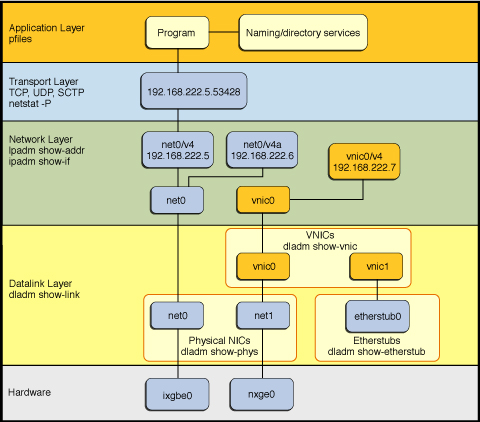Description of the Oracle Solaris Network Protocol Stack
Network interfaces provide a connection between a system and the network. These interfaces are configured over datalinks, which in turn correspond to instances of hardware devices on the system.
In Oracle Solaris 10, a one-to-one relationship that binds the device, the datalink, and the interface exists, which means network configuration is dependent on the hardware configuration and also the network topology. If changes are implemented in the hardware layer, for example, the replacement of a network interface card (NIC), you must reconfigure the interfaces on the system.
However, in this Oracle Solaris release, the naming of physical datalinks is no longer tied to the underlying hardware associated with the network device. By default, such devices are assigned the generic name net and a suffix that reflects the device's physical location in the system, as shown in Figure 1–1. With this separation, the network configuration on the network layer is no longer bound to the chipset or to the network topology in the hardware layer.
Figure 1-1 Oracle Solaris 11 Network Protocol Stack

-
Network configuration is insulated from any changes that might occur in the hardware layer. Link and interface configurations are preserved even if the underlying hardware is removed. These same configurations can then be reapplied to any replacement NIC, provided that the two NICs are of the same type.
-
The separation of the network configuration from the network hardware configuration enables the use of customized link names at the datalink layer.
-
With the abstraction of the datalink layer, multiple networking abstractions or configurations, such as virtual local area networks (VLANs), virtual network interface cards (VNICs), physical devices, link aggregations, and IP tunnels are unified into a common administrative entity, which is the datalink.
This implementation makes network administration more flexible in the following ways:
To compare the Oracle Solaris 10 network stack with the Oracle Solaris 11 network stack, see Comparing the Oracle Solaris 10 Network Protocol Stack to the Oracle Solaris 11 Network Protocol Stack in Transitioning From Oracle Solaris 10 to Oracle Solaris 11.2 .